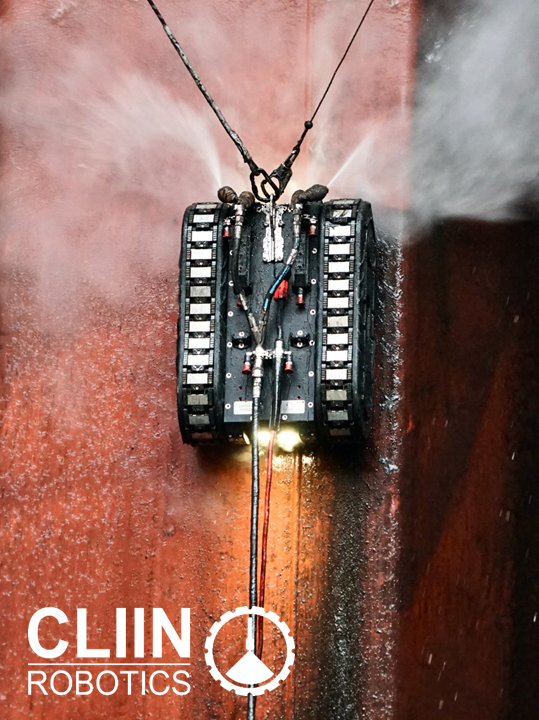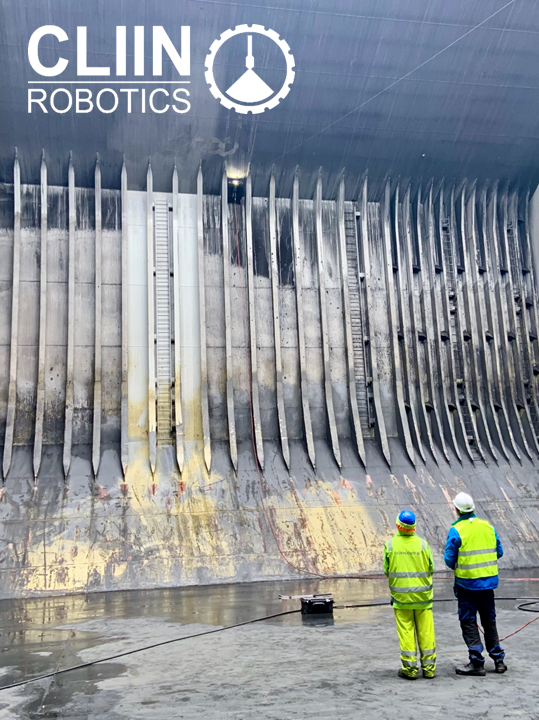Welcome to our FAQ page! Organized according to our solutions, this comprehensive guide addresses the most common questions our customers have about our products, policies, and services. If you're seeking information about a specific area, simply navigate to the relevant section below. If you can't find the answer you're looking for, our dedicated customer support team is here to help.
Additionally, for a closer look at our cutting-edge robotic solutions in action, don't forget to check out our YouTube channel. There, you'll find detailed demonstrations and explanations of how our products can revolutionize your operations.
GENERAL (MUC): 
Below, you'll find answers to the most frequently asked questions about our Magnetic Universal Crawler (MUC). Explore the solution here.
How does the robot stick to the wall?
The robot operates using permanent magnetic tracks and large magnets on the belly of the robot. The surface to be cleaned must be ferrous.
What is the cleaning speed of the robot?
The robot can clean an area of up to 800 m2 per hour, with the actual rate dependent on the structure being cleaned.
Is the robot wireless?
No, both the robot and the remote control are connected to the custom-designed High-Pressure System.
Does the robot reduce the environmental impact of cleaning?
Yes, the robot is designed for chemical-free cleaning which results in fewer chemicals being released into the ground and oceans.
Can the robot climb non-magnetic vertical surfaces?
No, the robot is designed to operate on magnetic tracks, limiting its ability to climb surfaces to those that are ferrous.
What is the weight of the robot?
85 kg.
Does the robot come in different sizes?
No, the robot is available in one size only, with dimensions of 747 x 562 x 310 mm [L x W x H].
Is a warranty included in the price?
Yes, a 6-month warranty is included. An additional 6-month extension is available for an extra cost.
Does the robot ever fall?
The robot may detach if the operator attempts to navigate an obstacle outside the robot's operational scope.
In such instances, the fall prevention/load arrestor system will engage to secure the robot, allowing operations to resume.
How much maintenance is required?
This depends on how tough an environment the robot is used in. External wearable spare parts are easily replaced by the user and have an expected average lifetime of 200 hours of usage.
The internal electronics of the robot are maintenance-free.
What is the maximum payload the robot can carry?
The robot can carry up to 250 kg on a vertical surface and can transition to 60-degree overhangs carrying 100 kg.
Are there multiple speed settings?
Yes, the robot has three preset speeds varying from 0,1 to 1,0 km/h. Furthermore, the speed can be adjusted by the operator using the joystick.
Does CLIIN Robotics offer training?
Yes, CLIIN offers onsite training for Operations and Maintenance staff.
How does cleaning with a robot improve safety?
Cleaning can be done from the ground level without dangerous climbing. Additionally, cleaning personnel will not be exposed to harmful chemicals.
Is the robot ATEX certified?
No, currently the robot is not ATEX-certified, but we will have a certified version by fall 2024.
 CARGO HOLD CLEANING:
CARGO HOLD CLEANING:
Below, you'll find answers to the most frequently asked questions about our Cargo Hold Cleaning Robot (CHR). Explore the solution here.
What cargoes can the robot clean?
The robot is capable of cleaning almost all cargoes without the use of chemicals ie. petcoke, coal, concentrates, and bauxite. The robot is also capable of cleaning cement and clinker with a combination of dry and wet cleaning.
How much of the cargo hold can the robot reach?
Depending on the structure of the cargo hold, the robot can reach up to 90% of the surface area.
Can the robot clean the upper hopper/ top wing tanks?
Yes, the magnet setup of the cargo hold robot enables it to access the upper hopper area.
How much water is normally consumed cleaning all cargo holds of a vessel?
Customer feedback says that the total water consumption varies from 45 tons for a box shaped Handy to 100 tons for Panamax.
How does CLIIN’s solution differ from others in the industry?
The Cargo Hold Robot is durable, easy to operate, and made of high-quality components which increases the cleaning quality, reduces the maintenance time, and helps the owner save costs in the long run. The Cargo Hold Robot is chemical-free and operated by 1-2 people operating the system using a remote control, reducing man hours and dangerous work at heights.
How does CLIIN’s Cargo Hold solution benefit the customer?
The owner of a Cargo Hold Robot, being a vessel owner/operator or a cleaning company, will benefit from a one-step cleaning procedure resulting in faster turnaround time, fewer chemicals, and even reduced labor required for cleaning operations.
At what water pressure does the robot clean?
The High-Pressure System applies a pressure of 200 bars, with a flow rate of 50 liters per minute. The resulting impact effect is 18 kW which is the maximum effect at a 32A outlet.
What is the ideal water temperature for cleaning?
Water, along with pressure, is typically effective in removing most types of dirt. By using an in-line heater, the water temperature can be adjusted to reach up to 90 degrees Celsius. Increasing the temperature of the water enhances cleaning speed and efficiency, particularly when dealing with greasy residues.
Can the pump operate using salt or brackish water?
Yes, a saltwater pump system is available as an add-on to the robot.
TANK CLEANING: 
Below, you'll find answers to the most frequently asked questions about our Tank Cleaning Robot (TCR). Explore the solution here.
How long does it take to clean a tank?
A 20-meter diameter tank can be cleaned in 1-2 working days on the outside and 2-3 days for the inside, depending on the nature of the tank product or residues.
How many people are needed to clean a storage tank with the robot?
It is a two-man job. One person operates the robot, and one assists the operator in keeping an overview of the equipment and moving the load arrestors across the tank while the cleaning operation is ongoing.
What water pressure is the robot using?
200 BAR - approx. 42L/min - approx. 2900 PSI - approx. 11 Gal/min
What is the water consumption?
Approx. 3.3L/m2 or 0.08 Gal / ft2
How does cleaning with a robot improve safety?
Cleaning can be done from the ground eliminating the need for manlifts and scaffolding. Additionally, the cleaning personnel will not be exposed to any harmful chemicals.
Can the pump operate using salt or brackish water?
Yes, a saltwater pump system is available as an a an optional add-on to the robot
Does it remove the sludge from the floor of the tank?
No, the robot is specialized in cleaning the inner and outer walls of the tank.
How does CLIIN’s solution differ from others in the industry?
The Tank Cleaning Robot is lightweight and user-friendly. Setup time is approx. one hour.
Two people can perform an entire tank cleaning operation (external and internal shells) without the need for cherry pickers or scaffolding.
How does CLIIN’s solution benefit the customer?
CLIIN's solution simplifies tank cleaning by eliminating the need for scaffolding and reducing the risk of working at heights. It also promotes sustainability by using only fresh water. Overall, it offers customers an efficient, safe, and environmentally friendly cleaning option.
 ROBOTIC ANTIFOULING:
ROBOTIC ANTIFOULING:
Below, you'll find answers to the most frequently asked questions about our Robotic Antifouling Solution. Explore the solution here.
Can the robot also clean above the water line?
Thanks to its magnetic tracks, our Robot is capable of cleaning both above and below the water line with ease
Can the robot use different tools?
The tools are easily exchangeable with a click-on/off system, making it possible to clean both above and below the waterline.
Can the robot be used onshore and offshore?
The robot's versatility allows for both onshore and offshore applications, providing a convenient solution for anytime, anywhere vessel maintenance.
How does the robot perform in different water conditions?
The system can efficiently move through strong currents above and below the water, ensuring complete cleaning and maintenance without affecting operations.
What types of marine biofouling does the robot target?
The robot targets various levels of marine biofouling, ranging from light slime to heavy fouling, optimizing hull performance in diverse conditions.
What cleaning technology does the Antifouling robot use?
The robot can be used with different types of brushes depending on the condition of the fouling and coating type.
How does proactive hull maintenance benefit vessel operations?
Proactive hull maintenance, such as keeping hull surfaces smooth, has been proven to reduce fuel consumption, resulting in lower greenhouse gas emissions and minimizing the transfer of invasive species.
Does the cleaning involve chemicals?
The robot only uses fresh water for cleaning and is therefore environmentally friendly and cost-effective.
Is the Antifouling Robot easy to operate?
The system's on-demand cleaning functions are remotely operated, ensuring ease, safety, and user-friendly operation.
Does the cleaning damage the paint?
No, our Hull Cleaning Robot (HCR) does not damage the paint. We are in the process of getting the necessary approvals from all painting manufacturers to ensure that our solution does not damage the paint.
Can the robot clean the niche areas of the hull?
No, the Hull Cleaning Robot (HCR) can only clean the vertical sides of the hull and the flat bottom.
What is the speed of the robot for cleaning and for grooming?
The cleaning speed of the HCR is 200-400m2 depending on the fouling level.
Can I use one robot for multiple purposes? (Hold & Hull cleaning)
Yes, by acquiring the necessary tools and equipment, you will be able to use your Hull Cleaning Robot (HCR) also for your Cargo Hold Cleaning operations.
How can I determine the robot's location while it is cleaning?
The HCR has a front and rear camera. Additionally, it has a depth sensor and a gyro sensor.
Patented and Patent pending - https://cliin.dk/patents-trademarks
